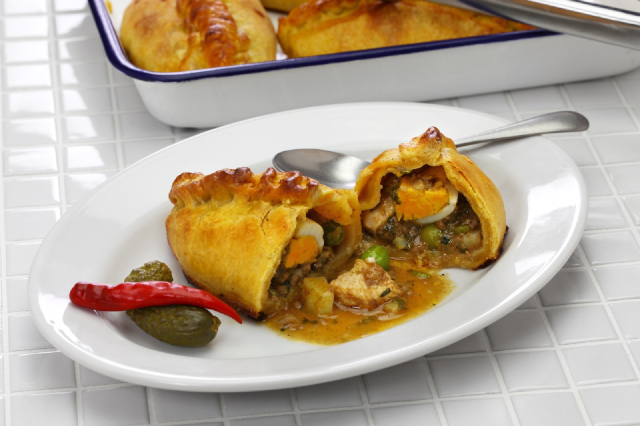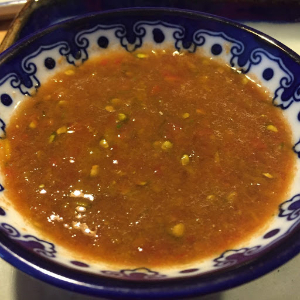Bolivia, to me, used to mean llamas, high mountains potatoes and pan flute music. But not great food. How wrong I was! Let me share with you some of the Bolivian foods I’ve discovered over the past little while, since sister Erin turned me on to one very special ‘food expedition’ website!
 Salteñas: Pastry pockets beloved by Bolivian diners – and all-too-familiar to Italian
Salteñas: Pastry pockets beloved by Bolivian diners – and all-too-familiar to Italian
and Mexican food lovers. Don’t even think about crediting ancient spacemen…
Bolivia – if you hadn’t paid much attention to it before now – turns out to be a pretty intriguing place. According to the uncredited author of the nomadparadise.com website focusing on Bolivian food, it’s, “…a large landlocked country in South America that has a relatively small population of only around 10 million people.”
The preface to the precis of Bolivia’s most iconic foods goes on:
“Bolivia may not have access to the ocean, but its geography is impressive anyway. It stretches from the dry and cold Andes mountains in the west to the humid and hot Amazon rain forest in the east. Bolivia was colonized by Spain just like most of their South American neighbors, yet still today almost 50 percent of the nation’s population is indigenous. Bolivian cuisine combines native foods with ingredients long ago introduced by Spain and results in a delicious celebration of food.”
Wow!
So let’s get to it, with a selection of Bolivian dishes which clearly show the Spanish influence, but also feature ingredients native to Bolivia; some found only in its unique climate and at its rarefied altitudes…
On our menu today…
Salteñas: This pastry pocket dish may look familiar. It has a lot in common, appearance wise, with the popular Italian Panzerotti, which in turn looks a lot like the Spanish/Mexican Empanada. But inside, it is stuffed with either Beef or Chicken Stew, which can be ordered either Sweet or Spicy. Other ingredients include onion, potato and peas. Some versions may also include olives and even a piece of hard-boiled egg. Olives? Wait until you read about some other Bolivian dishes! Salteñas is a street food made and sold by vendors found almost everywhere in the ‘settled’ parts of the country.
Llajwa: This is a simple, thick, smooth sauce (see photo, top of page) based on Tomatoes, with healthy additions of indigenous peppers and herbs. This staple condiment came originally from the low-altitude eastern regions of Bolivia but, in relatively recent times, has spread over the whole country. Bolivian cooks are said to bless the advent of electricity and the coming of the electric blender: before the modern appliance was available, they had to grind the Llajwa ingredients together between to two stones! Llajwa is used on pretty much everything by Bolivians – the way some Americans put Ketchup on everything.
Sopa de Mani: This is one of Bolivia’s more intriguing soups – of which there are many, from all over the country. What makes this dish special is that it’s made of fresh peanuts, which are native to Bolivia. And you thought they came from Africa! Anyway… The sopa is relatively complex (for Bolivian food) blend of ground raw (i.e.- not roasted) peanuts with diced tomato, diced onion, peas, cumin and oregano, all simmered in a rich, creamy beef broth. Another dish featuring tomatoes and onions. Starting to see a pattern, here?
Silpancho: Is a popular main dish that originated in one region of the country but spread across the land after modern communications and transportation systems united the culture. It also embodies several key characteristics shared by many Bolivian dishes. Silpancho is based on a thin, tenderized beefsteak (similar to an old-fashioned ‘minute steak’) which is breaded and pan fried (like a veal cutlet), and served with boiled or roasted root veggies and rice. Note that, like many other Bolivian main dishes, Silpancho is usually topped with a fried egg. Wait… A fried egg? Like Indonesian food? I hear you saying, “Could ancient spacemen have visited both…?” That’s not our bailiwick. Back to work.
Falso Conejo: Literally, ‘Fake Rabbit’, this is a dish that relies (again!) on Beef as its key protein component. It used to be made with real Rabbit, but Bolivians loved it so much that rabbits Became almost extinct there! Hence, the switch. Anyway, the Beef for this dish is tenderized as it is for Silpancho, then cut in thin strips and breaded. After frying it’s served with a sauce made of diced sweet pepper, onion, carrot, tomato, garlic, cubed potatoes and peas, over a bed of rice or pasta that is toasted before cooking. I’d like to find out more about that toasting technique. Sounds eerily similar to the way they make fried rice all over Asia. Ancient spacemen, again? Stop that! Stop it right now!
So there you have it…
Just a few samples of the most popular Bolivian foods. I find it intriguing that they have so many characteristics in common, yet also share so many characteristics with cuisines from other cultures scattered around the world! The ‘ancient spacemen’ theory aside, it just goes to show how many really good food prep techniques and combinations have developed independently and risen to the top of the pile in so many far-flung, varied culinary traditions from literally all over the globe. Get onto Google today and start digging up fully detailed recipes for the Bolivian family favourites showcased above, and celebrate the country’s truly unique national menu!
~ Maggie J.

